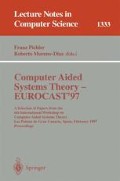Abstract
In this paper a general model, that allows different kinds of diagrams that appears in several fields of Science and Engineering to be integrated under the same representation, is proposed, and a computer aided graphical calculus system, enabling to manipulate these graphical representations in a semiautomatic way, is presented.
Traditionally most of these diagrams have been used as an aid in the development of complex calculus, although the lack of a solid theoretical foundation for this kind of representation has prevent the existence of general tools.
Suported by XUGA 105041396, XUGA 10505B96
Preview
Unable to display preview. Download preview PDF.
References
Burroni, A.: Higher Dimensonal Word Problem. Lecture Notes in Computer Science, Springer 530 (1991) 94–105
Caruncho, J. R.: Teoria de Triples. Alxebra 5, Dpto. Algebra y Fund. Univ. Santiago (1971)
Eilenberg, S., Kelly, M.: A Generalization of the Functorial Calculus. J. Algebra 3 (1966) 366–375.
Freyd, P. J., Yetter, D. N.: Braided Compact Closed Categories with Applications to Low Dimensional Topology. Advances in Mathematics 77 (1989) 156–182.
Huet, G., Lansdorf, D. S.: On the Uniform Halting Problem for Term Rewriting Systems. Rapport Laboria 283 INRIA (1978)
Joyal, A., Street, R.: The Geometry of Tensor Calculus I. Advances in Mathematics 88 (1991) 55–112.
Joyal, A., Street, R.: An Introduction to Tannaka Duality and Quantum Groups. Lecture Notes in Math., Springer 1488 (1991) 412–492.
Knuth, D. E., Bendix, P. B.: Simple Word problems in universal algebras. J. Leech (Ed.) Computational Problems in Abstrect Algebra, Pergamon Press, Oxford (1970) 265–297.
Lafont, Y.: Penrose diagrams and 2-dimensional rewriting. Applications of Categories in Computer Science (ed. M. P. Fourman, P. T. Johnstone, and A. M. Pitts), LMSLNS 177 Cambridge University Press (1992) 191–201.
Lafont, Y.: Ecuational Reasoning with 2-dimensional Diagrams Lecture Notes in Computer Science, Springer 909 (1993) 171–195.
Leroy, X.: The Objective Caml System, Release 1.03. Documentation and Users Manual. INRIA (1996).
MacLane, S.: Natural associativity and conmutativity. Rise Univ. Stud. 49 (1963) 28–46.
MacLane, S., Pare, R.: Coherence for bicategories and indexed categories. J. Pure Appl. Algebra 37 (1985) 59–80.
Majid, S. Quantum and Braided-Lie algebras. Journal of Geometry and Physics 13 North Holland (1994) 307–356.
Oesterhout, J. K.: Tcl and the Tk Toolkit. Addison-Wesley (1993).
Pessaux, F., Rouaix, F.: The Camltk interface. Release for Tk4.0. Project Cristal. INRIA, Rocquencourt.
Penrose, R., Rindler, W.: Spinors and space-time, Vol 1: Two-spinor calculus and relativistic fields. Cambridge University Press (1986).
Power, A. J.: A 2-Categorical Pasting Theorem. J. of Algebra 129 (1990) 439–445.
Reidemeister, K.: Knot Theory. B.C.S. Associates (1983).
Sawing, S.: Links, Quantum Groups and TQTFS. Bulletin (New Series) of the American Mathematical Society 33 N. 4 (1996) 413–445.
Shum, M. C.: Tortile tensor categories. Journal of Pure and Applied Algebra 93 (1994) 57–110.
Tamasia, R., Di Battista, G., Batini, C.: Automatic Graph Drawing and Readability of Diagrams. IEEE Transactions on Systems, Man, and Cybernetics, 18 N. 1 (1988) 61–79.
Turaev, V. G.: The Yang-Baxter equation and invariants of links. Inventiones Mathematicae 92 Springer Verlag (1988) 527–533.
Welch, B.: Practical Programming in Tcl and Tk. Prentice-Hall (1995).
Wechler, W.: Universal Algebra for Computer Scientists. EATCS Monographs on Theoretical Computer Science. Springer-Verlag (1992).
Author information
Authors and Affiliations
Editor information
Rights and permissions
Copyright information
© 1997 Springer-Verlag Berlin Heidelberg
About this paper
Cite this paper
Molinelli, J.M., Barja, J.M., Blanco, A., Fieire, J.L. (1997). An automatic calculator with penrose diagrams. In: Pichler, F., Moreno-Díaz, R. (eds) Computer Aided Systems Theory — EUROCAST'97. EUROCAST 1997. Lecture Notes in Computer Science, vol 1333. Springer, Berlin, Heidelberg. https://doi.org/10.1007/BFb0025048
Download citation
DOI: https://doi.org/10.1007/BFb0025048
Published:
Publisher Name: Springer, Berlin, Heidelberg
Print ISBN: 978-3-540-63811-7
Online ISBN: 978-3-540-69651-3
eBook Packages: Springer Book Archive

